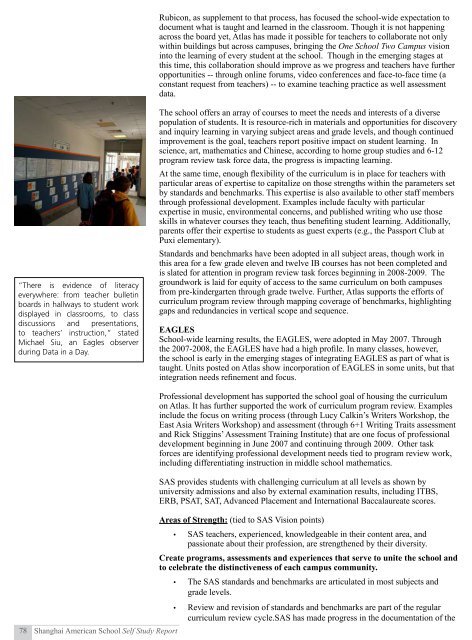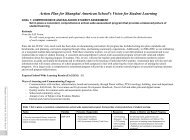Curriculum and Instruction - SAS-WASC
Curriculum and Instruction - SAS-WASC
Curriculum and Instruction - SAS-WASC
You also want an ePaper? Increase the reach of your titles
YUMPU automatically turns print PDFs into web optimized ePapers that Google loves.
Rubicon, as supplement to that process, has focused the school-wide expectation todocument what is taught <strong>and</strong> learned in the classroom. Though it is not happeningacross the board yet, Atlas has made it possible for teachers to collaborate not onlywithin buildings but across campuses, bringing the One School Two Campus visioninto the learning of every student at the school. Though in the emerging stages atthis time, this collaboration should improve as we progress <strong>and</strong> teachers have furtheropportunities -- through online forums, video conferences <strong>and</strong> face-to-face time (aconstant request from teachers) -- to examine teaching practice as well assessmentdata.“There is evidence of literacyeverywhere: from teacher bulletinboards in hallways to student workdisplayed in classrooms, to classdiscussions <strong>and</strong> presentations,to teachers’ instruction,” statedMichael Siu, an Eagles observerduring Data in a Day.The school offers an array of courses to meet the needs <strong>and</strong> interests of a diversepopulation of students. It is resource-rich in materials <strong>and</strong> opportunities for discovery<strong>and</strong> inquiry learning in varying subject areas <strong>and</strong> grade levels, <strong>and</strong> though continuedimprovement is the goal, teachers report positive impact on student learning. Inscience, art, mathematics <strong>and</strong> Chinese, according to home group studies <strong>and</strong> 6-12program review task force data, the progress is impacting learning.At the same time, enough flexibility of the curriculum is in place for teachers withparticular areas of expertise to capitalize on those strengths within the parameters setby st<strong>and</strong>ards <strong>and</strong> benchmarks. This expertise is also available to other staff membersthrough professional development. Examples include faculty with particularexpertise in music, environmental concerns, <strong>and</strong> published writing who use thoseskills in whatever courses they teach, thus benefiting student learning. Additionally,parents offer their expertise to students as guest experts (e.g., the Passport Club atPuxi elementary).St<strong>and</strong>ards <strong>and</strong> benchmarks have been adopted in all subject areas, though work inthis area for a few grade eleven <strong>and</strong> twelve IB courses has not been completed <strong>and</strong>is slated for attention in program review task forces beginning in 2008-2009. Thegroundwork is laid for equity of access to the same curriculum on both campusesfrom pre-kindergarten through grade twelve. Further, Atlas supports the efforts ofcurriculum program review through mapping coverage of benchmarks, highlightinggaps <strong>and</strong> redundancies in vertical scope <strong>and</strong> sequence.EAGLESSchool-wide learning results, the EAGLES, were adopted in May 2007. Throughthe 2007-2008, the EAGLES have had a high profile. In many classes, however,the school is early in the emerging stages of integrating EAGLES as part of what istaught. Units posted on Atlas show incorporation of EAGLES in some units, but thatintegration needs refinement <strong>and</strong> focus.Professional development has supported the school goal of housing the curriculumon Atlas. It has further supported the work of curriculum program review. Examplesinclude the focus on writing process (through Lucy Calkin’s Writers Workshop, theEast Asia Writers Workshop) <strong>and</strong> assessment (through 6+1 Writing Traits assessment<strong>and</strong> Rick Stiggins’ Assessment Training Institute) that are one focus of professionaldevelopment beginning in June 2007 <strong>and</strong> continuing through 2009. Other taskforces are identifying professional development needs tied to program review work,including differentiating instruction in middle school mathematics.<strong>SAS</strong> provides students with challenging curriculum at all levels as shown byuniversity admissions <strong>and</strong> also by external examination results, including ITBS,ERB, PSAT, SAT, Advanced Placement <strong>and</strong> International Baccalaureate scores.78Shanghai American School Self Study ReportAreas of Strength: (tied to <strong>SAS</strong> Vision points)• <strong>SAS</strong> teachers, experienced, knowledgeable in their content area, <strong>and</strong>passionate about their profession, are strengthened by their diversity.Create programs, assessments <strong>and</strong> experiences that serve to unite the school <strong>and</strong>to celebrate the distinctiveness of each campus community.• The <strong>SAS</strong> st<strong>and</strong>ards <strong>and</strong> benchmarks are articulated in most subjects <strong>and</strong>grade levels.• Review <strong>and</strong> revision of st<strong>and</strong>ards <strong>and</strong> benchmarks are part of the regularcurriculum review cycle.<strong>SAS</strong> has made progress in the documentation of the



